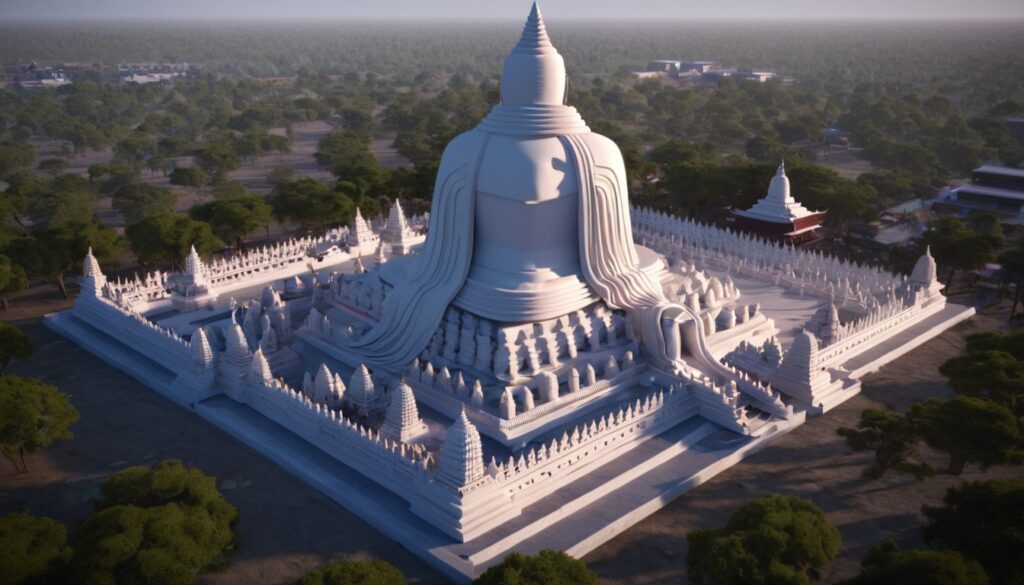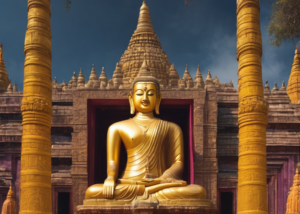Bodhgaya Bihar – The Birthplace of Buddhism
Travelers drawn to the birthplace of Buddhism find its spiritual atmosphere and tranquillity captivating. Buddhists from across the world come here to retrace Buddha’s steps and understand his philosophies. Bodhgaya Bihar
While visiting Bihar, don’t miss trying a Bihari Thali: an authentic feast featuring rice, dal, vegetables and chutneys served at local restaurants or can even be ordered online! This food can be found across many local eateries or ordered directly online. Bodhgaya Bihar

Table of Contents
Bodhgaya Bihar History
Bodhgaya, which translates to the Awakening or Enlightenment in English, is one of four major pilgrimage sites for Buddhists. Lumbini was where Siddhartha was born while KusiNagar and Sarnath are where he entered Nirvana and gave his first sermon, respectively. Bodhgaya is widely revered as being where Buddha achieved Enlightenment and thus become Buddha himself.
Emperor Ashoka created the Mahabodhi Temple to mark where Buddha meditated to achieve enlightenment under a Bo tree, in 3rd Century BCE. Later enclosed with stone railing (1st Century BCE), this simple shrine became holy ground of Buddhism’s history. According to legend, Buddha spent six years under this Bo tree meditating before defeating Mara, god of desire and illusion, thus leading him to achieve liberation from suffering and attaining Nirvana – his enlightenment was gained. Bodhgaya Bihar
Bodh Gaya became home to various monasteries to serve Buddhist pilgrims who came to pray at its sacred spot and meditate. These monasteries not only provided places of meditation and education, but also social services; thus establishing Bodh Gaya as an increasingly flourishing centre of religion and culture – at which point its name, which means “monastery”, became associated with Bihar as state name.
Today’s Bodhgaya temple complex is an eclectic mixture of temples and monasteries managed by various groups, each conducting their own rituals and prayers. As it remains constantly changing site, this research seeks to comprehend its complex interlocking web of interests that have combined, clashed, and ultimately formed Bodh Gaya into an international hub of Buddhist pilgrimage and tourism.
This study employs a qualitative approach, including interviews with international pilgrims and tourists to gain an insight into how history of a place has been shaped by their beliefs and practices. Furthermore, it uncovers how these visitors’ motivations have combined, impacted or sometimes competed with those of local stakeholders such as governments as well as populations within its boundaries. Bodhgaya Bihar
Bodhgaya Bihar Temples
Mahabodhi Temple in Bodhgaya is one of the must-visit sites, boasting several monuments and believed to be where Buddha attained enlightenment. Pilgrims from all over come here for worship and its shrines draw them in. Additionally, its exterior Bodhgaya Bihar
sandstone railing has carvings from Gupta period as well as statues and figurines depicting different periods in Buddhism history.
The Bodhi Tree stands as an essential landmark. Believed to be descended from Emperor Ashoka’s original tree planted at Dharani Temple in Bihar, it serves as an important Hindu and Buddhist site. With thousands of visitors coming daily and many wearing traditional maroon or saffron monk robes as they pray at this shrine dedicated to seated Buddha, many revere this holy site and consider it sacred.
Other notable sites within the complex include Animeshlochana Chaitya, where Buddha spent his first week after attaining enlightenment meditating and held his inaugural discourse. Locals frequently visit this spot for ritual worship services or puja ceremonies. Bodhgaya Bihar
Ratnachakrama, where Buddha walked back and forth 18 paces while meditating, is also significant to Buddhists, with a commemorative pillar to mark this event. Also of great interest are depictions of an Emaciated Buddha due to their intense penance, depicted on many pieces of art and used to teach new disciples about its principles.
Complex contains numerous smaller temples and stupas constructed over time. Some date back to Gupta period; others more modern; some influenced by both Indian and Chinese cultures while others have more modern designs. Temples have become major tourist draws as beautiful symbols that provide glimpses into history.
Bodhgaya Bihar Monasteries
Bodhgaya, recognized by UNESCO as a World Heritage Site, is an ancient Buddhist sacred site famous for the Mahabodhi Temple and Bodhi Tree. Bodhgaya boasts an illustrious past dating back millennia with stories and significance galore to share from across its Buddhist world and more locally as evidenced by its complex of structures, shrines, sculptures and more – each adding something significant without completely overshadowing what came before.
Inscriptions at Mahabodhi Temple date back to 3rd Century BCE, but its real significance dates to 5th Century CE, when Gautama Siddhartha finally attained enlightenment under the Bodhi Tree and thus, becoming Buddha, altering human history forever. From that point forward, events took place that gave rise to Buddhism as a religion, with Mahabodhi Temple eventually becoming known as Bodhgaya as its site of origin.
There are numerous monasteries in Bodhgaya that attract pilgrims and tourists from different nations worldwide. Each monastery boasts unique architecture and stunning murals depicting Buddha. Many also serve as meditation centers where visitors can come and spend some time relaxing peacefully while purchasing books and videos about Buddhism and its philosophy.
Bodhgaya’s most prominent monasteries include Bodhiyana Monastery, Barabar Caves, and Karma Dhargye Chokhorling – all located nearby Mahabodhi Temple. One of the main attractions in bodhgaya is its 80 feet tall statue of Buddha erected by government with help from local residents – it depicts him peacefully for easy photography opportunities! Additionally there are 10 disciples that helped Buddha achieve enlightenment erected either side of him who represented his main students that helped him attain this state.
Bodhgaya monastery is known for its intricately sculpted walls and shikhars adorned with gold, precious metals and gems. An 18th century traveler by the name of Xuanzang wrote of a magnificent structure over 150 feet high covered with golden Buddha statues; today this must-visit site for Buddhists is even larger!
Bodhgaya Bihar Local attractions
Bodh Gaya’s main draw is its Mahabodhi Temple complex, where Buddha sat under a Bodhi tree to gain enlightenment and become Buddha. A significant pilgrimage site since centuries past, not much is known about its early form or foundation.
The Bodhi Tree remains in place and serves as the centerpiece of this complex, which features many other structures as well. Illumination at night creates an especially tranquil and relaxing ambience; pilgrims may circumambulate and meditate under its stupa while non-Buddhists simply enjoy its serenity and beautiful surroundings.
Visitor can enjoy dining and beverages at many restaurants and cafes throughout the area, including seasonal offerings that change seasonally. There are also hotels nearby offering more remote retreat experiences for visitors looking for rest and relaxation.
International interest in Bodhgaya increased after Archaeological Survey of India restored Mahabodhi Temple complex in 1880s; as a result of this renovation, patronage and construction activities surged across town and its environs, significantly altering both physical and social landscapes of Bodhgaya. Many local and international stakeholders became entangled in its development which has caused profound transformation within Bodhgaya itself.
Bodh Gaya is a world-renowned Buddhist pilgrimage site and boasts an enormous tourist industry. While this can attract some unscrupulous drivers, scammers and beggars who impede peaceful prayer in the shrine, security in its main compound
ensures they do not interfere with the peaceful atmosphere inside; so prayers in many languages may be heard around town – along with cows (which are sacred animals to both Hindus and Buddhists alike), cows lining its streets (hitting or offending one is illegal) as well as children sent beg from around Bodh Gaya that may overwhelm some visitors – making Bodh Gaya an experience worth your while if only once! Bodhgaya Bihar


